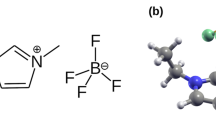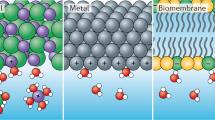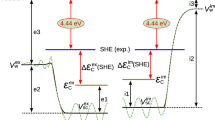Abstract
Of relevance to energy storage, electrochemistry and catalysis, ionic and dipolar liquids display unexpected behaviours—especially in confinement. Beyond adsorption, over-screening and crowding effects, experiments have highlighted novel phenomena, such as unconventional screening and the impact of the electronic nature—metallic versus insulating—of the confining surface. Such behaviours, which challenge existing frameworks, highlight the need for tools to fully embrace the properties of confined liquids. Here we introduce a novel approach that involves electronic screening while capturing molecular aspects of interfacial fluids. Although available strategies consider perfect metal or insulator surfaces, we build on the Thomas–Fermi formalism to develop an effective approach that deals with any imperfect metal between these asymptotes. Our approach describes electrostatic interactions within the metal through a ‘virtual’ Thomas–Fermi fluid of charged particles, whose Debye length sets the screening length λ. We show that this method captures the electrostatic interaction decay and electrochemical behaviour on varying λ. By applying this strategy to an ionic liquid, we unveil a wetting transition on switching from insulating to metallic conditions.
This is a preview of subscription content, access via your institution
Access options
Access Nature and 54 other Nature Portfolio journals
Get Nature+, our best-value online-access subscription
$29.99 / 30 days
cancel any time
Subscribe to this journal
Receive 12 print issues and online access
$259.00 per year
only $21.58 per issue
Buy this article
- Purchase on Springer Link
- Instant access to full article PDF
Prices may be subject to local taxes which are calculated during checkout






Similar content being viewed by others
Data availability
All the relevant simulation input scripts are available in this repository: Schlaich, Alexander, 2021, ‘Simulation input scripts for “Electronic screening using a virtual Thomas-Fermi fluid for predicting wetting and phase transitions of ionic liquids at metal surfaces”’, https://doi.org/10.18419/darus-2115, DaRUS.
Code availability
Molecular simulations were performed using the open source package LAMMPS, stable release 7 August 2019, available under https://www.lammps.org/. Post-processing was performed in Python using our open source toolbox MAICoS (https://gitlab.com/maicos-devel/maicos/).
References
Bocquet, L. & Charlaix, E. Nanofluidics, from bulk to interfaces. Chem. Soc. Rev. 39, 1073–1095 (2010).
Schoch, R. B., Han, J. & Renaud, P. Transport phenomena in nanofluidics. Rev. Mod. Phys. 80, 839–883 (2008).
Bazant, M. Z., Storey, B. D. & Kornyshev, A. A. Double layer in ionic liquids: overscreening versus crowding. Phys. Rev. Lett. 106, 046102 (2011).
Smith, A. M., Lee, A. A. & Perkin, S. The electrostatic screening length in concentrated electrolytes increases with concentration. J. Phys. Chem. Lett. 7, 2157–2163 (2016).
Lainé, A., Niguès, A., Bocquet, L. & Siria, A. Nanotribology of ionic liquids: transition to yielding response in nanometric confinement with metallic surfaces. Phys. Rev. X 10, 011068 (2020).
Fedorov, M. V. & Kornyshev, A. A. Ionic liquids at electrified interfaces. Chem. Rev. 114, 2978–3036 (2014).
Kaiser, V. et al. Electrostatic interactions between ions near Thomas–Fermi substrates and the surface energy of ionic crystals at imperfect metals. Faraday Discuss. 199, 129–158 (2017).
Dufils, T., Scalfi, L., Rotenberg, B. & Salanne, M. A semiclassical Thomas–Fermi model to tune the metallicity of electrodes in molecular simulations. J. Chem. Phys. 153, 174704 (2019).
Newns, D. M. Fermi–Thomas response of a metal surface to an external point charge. J. Chem. Phys. 50, 4572–4575 (1969).
Inkson, J. C. Many-body effect at metal-semiconductor junctions. II. The self energy and band structure distortion. J. Phys. C 6, 1350–1362 (1973).
Kornyshev, A. A., Rubinshtein, A. I. & Vorotyntsev, M. A. Image potential near a dielectric–plasma-like medium interface. Phys. Status Solidi B 84, 125–132 (1977).
Luque, N. B. & Schmickler, W. The electric double layer on graphite. Electrochim. Acta 71, 82–85 (2012).
Kornyshev, A. A., Luque, N. B. & Schmickler, W. Differential capacitance of ionic liquid interface with graphite: the story of two double layers. J. Solid State Electrochem. 18, 1345–1349 (2014).
Netz, R. R. Debye–Hückel theory for interfacial geometries. Phys. Rev. E 60, 3174–3182 (1999).
Lee, A. A. & Perkin, S. Ion–image interactions and phase transition at electrolyte–metal Interfaces. J. Phys. Chem. Lett. 7, 2753–2757 (2016).
Bedrov, D. et al. Molecular dynamics simulations of ionic liquids and electrolytes using polarizable force fields. Chem. Rev. 119, 7940–7995 (2019).
Breitsprecher, K., Szuttor, K. & Holm, C. Electrode models for ionic liquid-based capacitors. J. Phys. Chem. C 119, 22445–22451 (2015).
Comtet, J. et al. Nanoscale capillary freezing of ionic liquids confined between metallic interfaces and the role of electronic screening. Nat. Mater. 16, 634–639 (2017).
Ashcroft, N. W. & Mermin, N. D. Solid State Physics (Holt, Rinehart and Winston, 1976).
dos Santos, A. P., Girotto, M. & Levin, Y. Simulations of Coulomb systems confined by polarizable surfaces using periodic Green functions. J. Chem. Phys. 147, 184105 (2017).
Siepmann, J. I. & Sprik, M. Influence of surface topology and electrostatic potential on water/electrode systems. J. Chem. Phys. 102, 511–524 (1995).
Reed, S. K., Lanning, O. J. & Madden, P. A. Electrochemical interface between an ionic liquid and a model metallic electrode. J. Chem. Phys. 126, 084704 (2007).
Tyagi, S. et al. An iterative, fast, linear-scaling method for computing induced charges on arbitrary dielectric boundaries. J. Chem. Phys. 132, 154112 (2010).
Arnold, A. et al. Efficient algorithms for electrostatic interactions including dielectric contrasts. Entropy 15, 4569–4588 (2013).
Nguyen, T. D., Li, H., Bagchi, D., Solis, F. J. & Olvera de la Cruz, M. Incorporating surface polarization effects into large-scale coarse-grained molecular dynamics simulation. Computer Phys. Commun. 241, 80–91 (2019).
Torrie, G. M. & Valleau, J. P. Double layer structure at the interface between two immiscible electrolyte solutions. J. Electroanal. Chem. Interfacial Electrochem. 206, 69–79 (1986).
Kornyshev, A. A. & Vorotyntsev, M. A. Nonlocal electrostatic approach to the double layer and adsorption at the electrode–electrolyte interface. Surf. Sci. 101, 23–48 (1980).
Vorotyntsev, M. A. in Modern Aspects of Electrochemistry Vol. 17 (eds Bockris, J. O., Conway, B. E. & White, R. E.) 131–222 (Springer, 1986).
Kornyshev, A. A. & Vorotyntsev, M. A. Electrostatic interaction at the metal/dielectric interface. Sov. Phys. JETP 51, 509–513 (1980).
Vorotyntsev, M. A. in The Chemical Physics of Solvation. Part C: Solvation Phenomena in Specific Physical, Chemical and Biological Systems (eds Dogonadze, R. R., Kalman, E., Kornyshev, A. A. & Ulstrup, J.) 401–432 (Elsevier, 1988).
Kornyshev, A. A. & Schmickler, W. On the coverage dependence of the partial charge transfer coefficient. J. Electroanalytical Chem. Interfacial Electrochem. 202, 1–21 (1986).
Vorotyntsev, M., Kornyshev, A. & Rubinshtein, A. Possible mechanisms of controlling ionic interaction at the electrode–solution interface. Sov. Electrochem. 16, 65–67 (1980).
Kornyshev, A. A. Metal electrons in the double layer theory. Electrochim. Acta 34, 1829–1847 (1989).
Gerischer, H. An interpretation of the double layer capacity of graphite electrodes in relation to the density of states at the Fermi level. J. Phys. Chem. 89, 4249–4251 (1985).
Gerischer, H., McIntyre, R., Scherson, D. & Storck, W. Density of the electronic states of graphite: derivation from differential capacitance measurements. J. Phys. Chem. 91, 1930–1935 (1987).
Kondrat, S. & Kornyshev, A. Superionic state in double-layer capacitors with nanoporous electrodes. J. Phys. Condens. Matter 23, 022201 (2010).
Li, Z., Mendez-Morales, T. & Salanne, M. Computer simulation studies of nanoporous carbon-based electrochemical capacitors. Curr. Opin. Electrochem. 9, 81–86 (2018).
Rochester, C. C., Lee, A. A., Pruessner, G. & Kornyshev, A. A. Interionic interactions in conducting nanoconfinement. ChemPhysChem 14, 4121–4125 (2013).
Mohammadzadeh, L. et al. On the energetics of ions in carbon and gold nanotubes. ChemPhysChem 17, 78–85 (2016).
Bi, S. et al. Minimizing the electrosorption of water from humid ionic liquids on electrodes. Nat. Commun. 9, 5222 (2018).
Anwar, J., Frenkel, D. & Noro, M. G. Calculation of the melting point of NaCl by molecular simulation. J. Chem. Phys. 118, 728–735 (2002).
Nijmeijer, M. J. P., Bruin, C., Bakker, A. F. & van Leeuwen, J. M. J. Wetting and drying of an inert wall by a fluid in a molecular-dynamics simulation. Phys. Rev. A 42, 6052 (1990).
de Gennes, P. G. Wetting: statics and dynamics. Rev. Mod. Phys. 57, 827–863 (1985).
Rowlinson, J. S. & Widom, B. Molecular Theory of Capillarity (Clarendon Press, 1989).
Bonn, D., Eggers, J., Indekeu, J., Meunier, J. & Rolley, E. Wetting and spreading. Rev. Mod. Phys. 81, 739–805 (2009).
Evans, R., Stewart, M. C. & Wilding, N. B. A unified description of hydrophilic and superhydrophobic surfaces in terms of the wetting and drying transitions of liquids. Proc. Natl Acad. Sci. USA 116, 23901–23908 (2019).
Damaskin, B. Adsorption of Organic Compounds on Electrodes (Springer, 2012).
Plimpton, S. Fast parallel algorithms for short-range molecular dynamics. J. Comput. Phys. 117, 1–19 (1995).
Yeh, I.-C. & Berkowitz, M. L. Ewald summation for systems with slab geometry. J. Chem. Phys. 111, 3155–3162 (1999).
Acknowledgements
We acknowledge V. Kaiser for his help with the TF model and computation time through CIMENT infrastructure (Rhône-Alpes CPER07_13 CIRA) and the Equip@Meso project (ANR-10-EQPX-29-01). We also acknowledge funding from the ANR project TAMTAM (ANR-15-CE08-0008-01). A.S. acknowledges funding from the DFG under Germany’s Excellence Strategy—EXC 2075–390740016 and SFB 1313 (project no. 327154368) and support by the Stuttgart Center for Simulation Science (SimTech).
Author information
Authors and Affiliations
Contributions
B.C., L.B. and A.S. conceived the research. A.S. carried out the molecular simulations with support from D.J. A.S., B.C. and L.B. analysed the data. A.S. and B.C. wrote the paper with input from all authors.
Corresponding author
Ethics declarations
Competing interests
The authors declare no competing interests.
Additional information
Peer review information Nature Materials thanks the anonymous reviewers for their contribution to the peer review of this work.
Publisher’s note Springer Nature remains neutral with regard to jurisdictional claims in published maps and institutional affiliations.
Supplementary information
Supplementary Information
Supplementary Figs. 1–13, Table 1, analytical treatment of the TF model and further detail on methods.
Rights and permissions
About this article
Cite this article
Schlaich, A., Jin, D., Bocquet, L. et al. Electronic screening using a virtual Thomas–Fermi fluid for predicting wetting and phase transitions of ionic liquids at metal surfaces. Nat. Mater. 21, 237–245 (2022). https://doi.org/10.1038/s41563-021-01121-0
Received:
Accepted:
Published:
Issue Date:
DOI: https://doi.org/10.1038/s41563-021-01121-0



